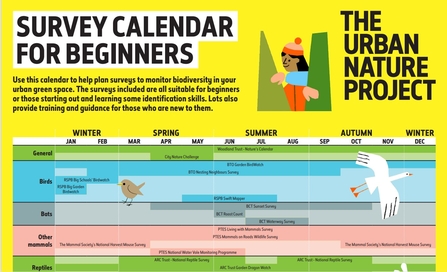Wildlife monitoring in a nutshell means looking for wildlife such as plants, animals and fungi and then logging what you find, where you’ve found them, and the time/date you’ve found them.
Other words and phrases are also used to describe elements of wildlife monitoring such as citizen science, BioBlitz and biological recording.
Some people record their sightings by using apps, some annotate paper maps and record cards which they can then upload onto websites.
Some people look for a specific group of creatures at a particular spot over time, others might try and log everything they see in a site over a day - there’s lots of different ways you can help record wildlife and you don’t need to be an expert to get started! This blog aims to give an overview of what wildlife monitoring is, why it matters and how you can get involved in a way which suits you best.
Where to start?
-
Find a site and choose a species or a group of species you’d like to record. This survey calendar displays many of the different wildlife monitoring events you can get involved with across the year – from Big Garden Birdwatch to counting frogs, there’s something for everyone. The calendar is interactive, click on the survey which takes your interest to find out more.
-
The Natural History Museum in London have created a ‘Nature Recording Hub’ full of top tips and resources.
-
For further support you can also join your local natural history society or environmental action group. In Bristol, we have the Bristol Naturalists Society amongst many local groups such as the RSPB Local Group, Bristol Ornithology Club and many action groups.
-
Find out more and get support to monitor wildlife in Bristol-based green spaces owned by Bristol City Council - Monitor wildlife in our parks (bristol.gov.uk).
-
No matter what scheme you take part in, always remember to also log your records with BRERC, our local environmental records centre to inform conservation efforts in the local area. Find out more about BRERC and how to submit a wildlife sighting.









